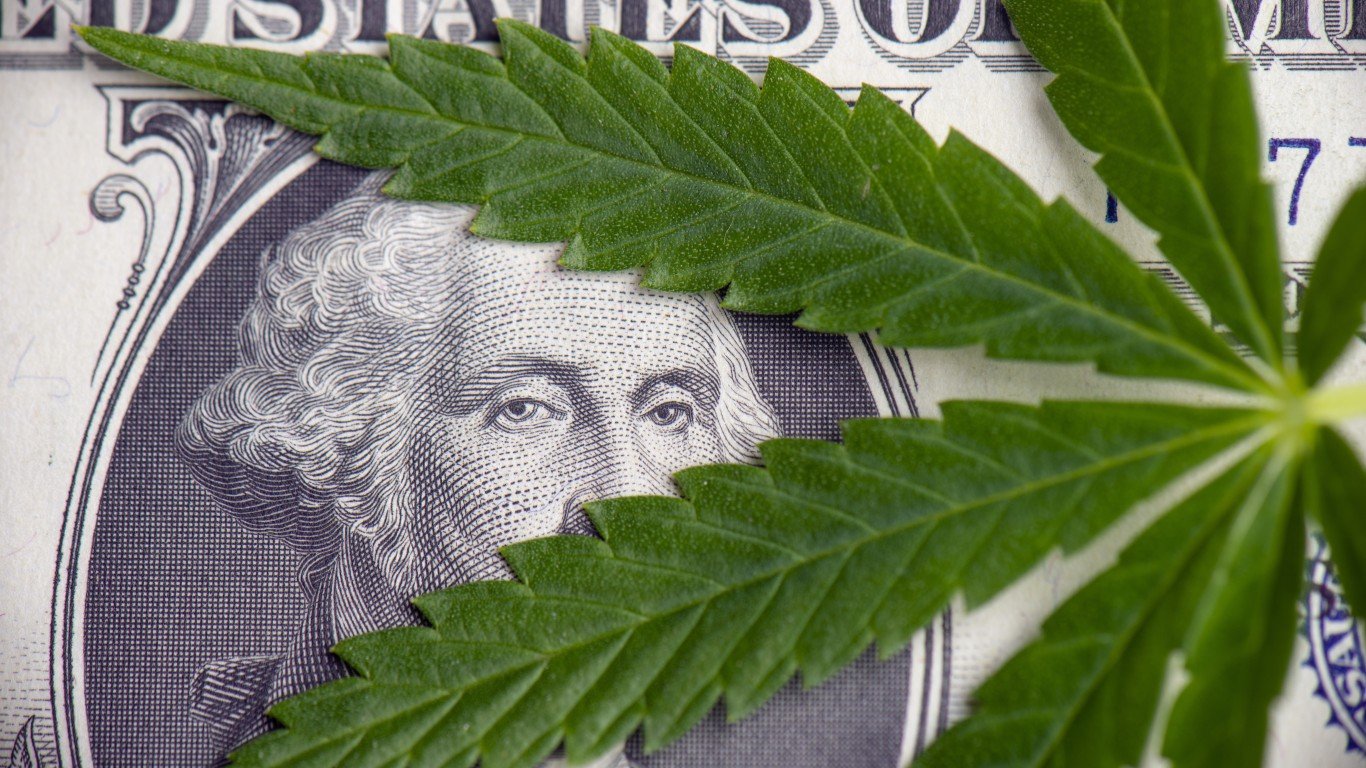

When Canadian cannabis grower Tilray Inc. (NASDAQ: TLRY) came public in the United States in July of 2018, the company’s initial public offering priced at $17 a share, above the expected range of $14 to $16. On January 10, 2019, the shares closed at $15.55.
In just over two months after its IPO, Tilray shares posted a high of more than $300 a share. Pot stocks, as a group, have taken a beating over the past year after a price run-up fueled by sin stocks in the alcoholic beverage, tobacco and gambling sectors.
In an effort to extend their beverage brands into pot-infused choices, beer and wine giant Constellation Brands Inc. (NYSE: STZ) and brewer Molson Coors (NYSE: TAP) have invested billions in Canopy Growth Corp. (NYSE: CGC) and Aurora Cannabis Inc. (NYSE: ACB). Tobacco giant Altria Group Inc. (NYSE: MO) placed huge bets on Cronos Group Inc. (NYSE: CRON) and e-cigarette maker Juul.
Most of those investments were made in the second half of 2018, following the January start to legal recreational weed sales in California. Marijuana stocks, particularly those for cultivators like Tilray, Canopy Growth and Aurora, seemed well-positioned to take advantage of booming demand as more high-population states were poised to follow suit. Then everything went up in smoke.
Pot Stocks Got High on Hope
It costs about $10,000 to raise either an acre of cannabis or an acre of tomatoes. That acre will produce 1,000 pounds of marijuana or about 37,500 pounds of tomatoes. Production cost per pound of $10 applies to cannabis while growing tomatoes costs about $0.27 a pound.
Medium-quality marijuana sells for around $285 an ounce on average in the United States. That’s a gross profit of $4,550 per pound, or $4.56 million per acre.
The retail price of tomatoes was about $2.17 a pound in 2018, not all of which goes to the farmer. Gross profit on an acre of tomatoes is around $81,375. One acre of weed earns as much as 56 acres of tomatoes. That’s a brass ring worth reaching for.
What the Recreational Cannabis Market Is Worth
Data from 2019 is not available yet, but in the seven states where legal recreational marijuana sales were happening in 2018, the total sales volume for the year was more than $6 billion. Tax revenues totaled more than $1.1 billion.
The following table shows the 11 states that have legalized sales of recreational marijuana. Two, Michigan and Illinois, only kicked off legal sales in late 2019 or early 2020. Maine and Vermont have not yet set up their regulatory and tax regimes.
| Legislation Passed | First Sales | Statewide Sales 2018 | Tax Revenue 2018 | |
|---|---|---|---|---|
| Colorado | Nov-12 | Jan-14 | $1.55 billion | $254.30 million |
| Washington | Nov-12 | Jul-14 | $1.00 billion | $376.10 million |
| Oregon | Nov-14 | Oct-15 | $777.60 million | $94.23 million |
| Alaska | Nov-14 | Oct-16 | $39.50 million | $15.70 million |
| Nevada | Nov-16 | Jan-17 | $102.70 million | $86.90 million |
| California | Nov-16 | Jan-18 | $2.75 billion | $345.20 million |
| Massachusetts | Nov-16 | Nov-18 | $106.00 million | $678,100 |
| Maine | Nov-16 | n/a | n/a | n/a |
| Vermont | Jan-18 | n/a | n/a | n/a |
| Michigan | Nov-18 | Dec-19 | n/a | n/a |
| Illinois | May-19 | Jan-20 | n/a | n/a |
These sales do not include medical cannabis sales. There were 14 additional states that allowed medical marijuana sales in 2018. Medical marijuana sales in those states totaled $1.46 billion.
The Stock Market Loves Pot; the Federal Government, Not So Much
As billions of investment dollars poured in, the cultivators ran into several difficulties. Most of the publicly traded pot growers are domiciled in Canada, the first nation of significant size to legalize recreational marijuana. From the market’s point of view, growing cannabis where federal law makes it legal is a winner. So is proximity to the United States, where the federal government still classifies marijuana as a Schedule I drug, the same category as heroin, cocaine and other dangerous drugs.
Regulating the new cannabis industry took longer than expected. Legal sales of recreational pot in Canada did not begin until the fall of 2018, even though legislation approving sales was passed almost 18 months earlier. The chart above shows the gaps for U.S. states.
Federal banking laws in the United States also do not allow banks to provide services for businesses that violate federal law. The U.S. House approved the SAFE Banking Act in September of 2019 that would enable cannabis businesses to have bank accounts, but the Senate has not yet passed the legislation.
There’s Also Plenty of Room for Competition
A bigger problem for the cannabis industry may be competition. In some cases from licensed growers who produce more than the state market can consume. In California, however, illegal growers undercut the legal cannabis companies that aren’t able to produce enough to meet demand.
Because unlicensed growers do not have to play by the same rules (no taxes, for example), they can sell their product for less. In California, the illicit cannabis market supports three times as many sellers as does the legal, regulated market. A study by a California group of legal marijuana businesses, the United Cannabis Business Association, found that about 2,835 businesses, including storefronts and delivery services, are operating illegally in the state. The state has licensed just 873 businesses, less than a third as many.
State regulators weren’t counting on this effect, at least not to the degree to which it has come. Enforcing licensing regulations adds to the state’s cost, which cuts into tax receipts. Tax revenues are the primary reason that California and other state governments have legalized recreational use of marijuana.
What Does a Licensed Grower Do Now?
When Tilray, Aurora Cannabis and Canopy Growth filed for their initial public offerings, all three talked about expanding their cultivation. But the Canadian market couldn’t absorb that much production of smokable pot, and that put Tilray on a different expansion path.
The company began exporting cannabis flower to Germany and Israel and acquired smaller companies that were producing edibles or cannabidiol-based (CBD) products that do not contain the psychoactive ingredient tetrahydrocannabinol (THC). While edibles are regulated, CBD products are not, as long as a company does not make claims about the products that run afoul of agencies like the U.S. Food and Drug Administration.
Then, in December 2018, the U.S. government removed hemp from its list of Schedule I drugs. Tilray spent about $55 million to acquire cultivator Natura and $316 million to acquire Manitoba Harvest, a maker of hemp-based edibles. The company then merged with Seattle-based private equity firm Privateer Holdings in July in a deal valued at $2.9 billion.
Cash and equivalents shrank from around $487 million in the third quarter of 2018 to $100 million 12 months later. Long-term debt only increased by about $8 million to $428 million in the same period. The net debt to EBITDA ratio dropped from a positive 1.1× to a negative 2.3×.
Cash flow from operations dropped from a negative $19.8 million to negative $57.0 million in the 12 months through September 2019. Capital spending doubled to $24.2 million, and levered free cash flow tumbled from negative $27.5 million to negative $133.2 million.
Tilray’s enterprise value has dropped from about $6.25 billion in September 2018 to around $2.12 billion 12 months later. Investors are not convinced that spending on expanding cultivation capacity and on entering the hyper-competitive CBD market at the same time is going to get Tilray back on a growth trajectory.
Sponsored: Attention Savvy Investors: Speak to 3 Financial Experts – FREE
Ever wanted an extra set of eyes on an investment you’re considering? Now you can speak with up to 3 financial experts in your area for FREE. By simply
clicking here you can begin to match with financial professionals who can help guide you through the financial decisions you’re making. And the best part? The first conversation with them is free.
Click here to match with up to 3 financial pros who would be excited to help you make financial decisions.
Thank you for reading! Have some feedback for us?
Contact the 24/7 Wall St. editorial team.



